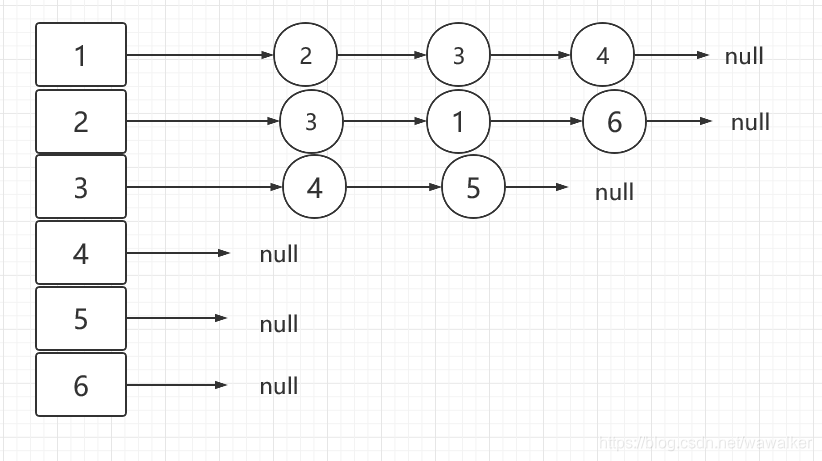?数据结构:
#define MaxVertexNum 100
typedef struct ArcNode{
int adjvex;
ArcNode *next;
}ArcNode;
typedef struct VNode{
int data;
ArcNode *first;
}VNode,AdjList[MaxVertexNum];
typedef struct{
AdjList vertices;
int vexnum,arcnum;
}ALGraph;
int visited[MaxVertexNum] = {false};
void visit(VNode node){
printf("%d",node.data);
}
int FirstNeighbor(ALGraph graph,int i){
VNode node = graph.vertices[i];
return node.first!= nullptr ? node.first->adjvex:-1;
}
int NextNeighbor(ALGraph graph,int i,int j){
ArcNode *node = graph.vertices[i].first;
while(node!= nullptr){
if(node->adjvex == j){
return node->next != nullptr ? node->next->adjvex : -1;
}
node = node->next;
}
} VNode node1;
node1.data= 1;
VNode node2;
node2.data= 2;
VNode node3;
node3.data= 3;
VNode node4;
node4.data= 4;
VNode node5;
node5.data= 5;
VNode node6;
node6.data= 6;
node3.first= nullptr;
ALGraph graph;
ArcNode anode12;
anode12.adjvex=2;
node1.first = &anode12;
ArcNode anode13;
anode13.adjvex = 3;
anode12.next = &anode13;
ArcNode anode14;
anode14.adjvex=4;
anode13.next = &anode14;
anode14.next = nullptr;
ArcNode anode23;
anode23.adjvex = 3;
node2.first = &anode23;
ArcNode anode26;
anode26.adjvex=6;
anode26.next= nullptr;
node6.first = nullptr;
ArcNode anode21;
anode21.next = &anode26;
anode21.adjvex=1;
anode23.next = &anode21;
ArcNode anode34;
anode34.adjvex=4;
node3.first = &anode34;
ArcNode anode35;
anode35.adjvex=5;
anode34.next = &anode35;
anode35.next = nullptr;
node4.first= nullptr;
node5.first= nullptr;
graph.vertices[1] = node1;
graph.vertices[2] = node2;
graph.vertices[3] = node3;
graph.vertices[4] = node4;
graph.vertices[5] = node5;
graph.vertices[6] = node6;邻接表:

?图:

?
一、深度优先(DFS)
typedef struct{
AdjList list;
int p;
}Stack;
void push(Stack &stack,VNode node){
stack.list[stack.p++] = node;
}
VNode pop(Stack &stack){
return stack.list[--stack.p];
}
void initStack(Stack &stack){
stack.p=0;
}
(1)递归
void DFS(ALGraph graph,int i){ //i开始结点序号
printf("%d",i);
visited[i] = true;
for(int w = FirstNeighbor(graph,i);w!=-1;w = NextNeighbor(graph,i,w)){
if(visited[w]==false){
DFS(graph,w); //递归
}
}
}(2)借助栈
void DFS_stack(ALGraph graph,int i){
Stack stack;
initStack(stack); //初始化栈
VNode node = graph.vertices[i];
visit(graph.vertices[i]);
visited[i] = true; //结点已访问标记
push(stack,graph.vertices[i]); //将结点入栈
while(stack.p!=0){ //栈不为空
VNode vnode = pop(stack); //出栈一个元素
for(int w = FirstNeighbor(graph,vnode.data);w!=-1;w = NextNeighbor(graph,vnode.data,w)){ //遍历元素所有相邻结点
if(visited[w]==false){
visited[w]=true;
push(stack,graph.vertices[w]); //相邻结点依次入栈
visit(graph.vertices[w]);
}
}
}
}二、广度优先(BFS)
typedef struct{
AdjList list;
int head;
int rear;
}Queue;
void initQueue(Queue &queue){
queue.rear = 0;
queue.head = 0;
}
void enQueue(Queue &queue,VNode node){
queue.list[queue.rear++] = node;
}
VNode deQueue(Queue &queue){
if(queue.head!=queue.rear){
return queue.list[queue.head++];
}
}void BFS(ALGraph graph,int i){
Queue queue;
initQueue(queue);
if(visited[i]==false){
visited[i]=true;
enQueue(queue, graph.vertices[i]);
visit(graph.vertices[i]);
}
while(queue.head!=queue.rear) {
i = deQueue(queue).data; //出队列
for (int w = FirstNeighbor(graph, i); w != -1; w = NextNeighbor(graph, i, w)) {
if(visited[w]==false) {
enQueue(queue, graph.vertices[w]); //进队列
visited[w] = true;
visit(graph.vertices[w]);
}
}
}
}结点序列:
// DFS(graph,1); //深度序列结果:123456
// DFS_stack(graph,1); //深度序列结果:123456
BFS(graph,1); //广度序列结果:123465